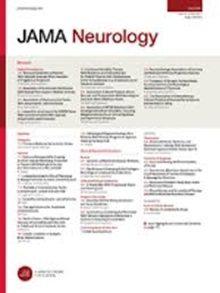钆增强动脉瘤壁成像与颅内动脉瘤生长或破裂的风险。
IF 21.3
1区 医学
Q1 CLINICAL NEUROLOGY
引用次数: 0
摘要
最近对未破裂颅内动脉瘤(UIAs)患者的纵向研究表明,磁共振成像(MRI)上的动脉瘤壁增强(AWE)可以预测生长和破裂。然而,由于这些研究受样本量小和随访时间短的限制,尚不清楚该放射生物标志物是否对UIA不稳定性具有预测价值。目的确定合并AWE的UIA患者4年不稳定风险,并探讨AWE是否为UIA不稳定的独立预测因子。设计、环境和参与者个体患者数据来自2017年1月至2024年12月在83个中国中心进行的3项前瞻性多中心队列研究。纳入的患者年龄在18至75岁之间,至少有1例无症状的囊性UIA大于或等于3mm。所有患者基线时均行3- t MRI钆增强动脉瘤壁成像和计算机断层血管造影(CTA),随访时行CTA。主要观察指标随访期间动脉瘤生长或破裂(不稳定性)为主要观察指标。在基线动脉瘤壁成像后4年,采用Kaplan-Meier估计法确定了有周向、局灶性和无AWE的uas患者动脉瘤不稳定的绝对风险。采用Cox比例风险回归研究AWE作为不稳定性的潜在预测因子。结果在1453例基线3-T MRI动脉瘤壁成像患者中,41例患者因缺少随访或无随访CTA而被排除,61例患者因CTA质量低而被排除。我们纳入1351例患者(中位[IQR]年龄,56[48-63]岁;750例女性[56%]),1416例uia和4884例动脉瘤-年随访。1416例uia中,4年内发生不稳定的有235例(16.6%)。4年不稳定的绝对累积风险在有周向AWE的uia中为36.8% (95% CI, 30.7%-43.0%),在有局灶AWE的uia中为17.2% (95% CI, 13.4%-21.1%),在没有AWE的uia中为11.4% (95% CI, 11.9%-16.1%)。环形AWE预测4年不稳定性(风险比[HR], 3.80; 95% CI, 2.82-5.14),调整大小比、动脉瘤位置、动脉瘤形状和分叉配置后(调整风险比,2.21;95% CI, 1.56-3.13)。结论和相关性:基线壁成像后4年内,三分之一的uas伴周向AWE发生不稳定。这些结果提示,MRI动脉瘤壁成像可用于预测动脉瘤不稳定的风险。本文章由计算机程序翻译,如有差异,请以英文原文为准。
Gadolinium-Enhanced Aneurysm Wall Imaging and Risk of Intracranial Aneurysm Growth or Rupture.
Importance
Recent longitudinal studies in patients with unruptured intracranial aneurysms (UIAs) suggested that aneurysm wall enhancement (AWE) on magnetic resonance imaging (MRI) predicts growth and rupture. However, because these studies were limited by small sample size and short follow-up duration, it remains unclear whether this radiological biomarker has predictive value for UIA instability.
Objective
To determine the 4-year risk of instability of UIAs with AWE and investigate whether AWE is an independent predictor of UIA instability.
Design, Setting, and Participants
Individual patient data were obtained from 3 prospective multicenter cohort studies conducted in 83 Chinese centers between January 2017 and December 2024. Included were patients aged 18 to 75 years with at least 1 asymptomatic, saccular UIA greater than or equal to 3 mm.
Exposures
All patients had 3-T MRI gadolinium-enhanced aneurysm wall imaging and computed tomography angiography (CTA) at baseline, and CTA at follow-up.
Main Outcomes and Measures
The primary outcome measure was aneurysm growth or rupture (instability) during follow-up. The absolute risk of aneurysm instability in UIAs with circumferential, focal, and no AWE was determined with Kaplan-Meier estimates at 4 years after baseline aneurysm wall imaging. Cox proportional hazards regression was used to investigate AWE as a potential predictor of instability.
Results
Of the 1453 patients who had baseline 3-T MRI aneurysm wall imaging, 41 patients were excluded because of loss to follow-up or no follow-up CTA, and 61 patients were excluded because of low-quality CTA. We included 1351 patients (median [IQR] age, 56 [48-63] years; 750 female [56%]) with 1416 UIAs and 4884 aneurysm-years of follow-up. Instability within 4 years occurred in 235 of 1416 UIAs (16.6%). The absolute cumulative risk of instability at 4 years was 36.8% (95% CI, 30.7%-43.0%) in UIAs with circumferential AWE, 17.2% (95% CI, 13.4%-21.1%) in UIAs with focal AWE, and 11.4% (95% CI, 11.9%-16.1%) in UIAs with no AWE. Circumferential AWE predicted 4-year instability (hazard ratio [HR], 3.80; 95% CI, 2.82-5.14) and after adjusting for size ratio, aneurysm location, aneurysm shape, and bifurcation configuration (adjusted HR, 2.21; 95% CI, 1.56-3.13).
Conclusions and Relevance
Within 4 years after baseline wall imaging, instability occurred in one-third of UIAs with circumferential AWE. These results suggest that MRI aneurysm wall imaging may be used for predicting the risk of aneurysm instability.
求助全文
通过发布文献求助,成功后即可免费获取论文全文。
去求助
来源期刊

JAMA neurology
CLINICAL NEUROLOGY-
CiteScore
41.90
自引率
1.70%
发文量
250
期刊介绍:
JAMA Neurology is an international peer-reviewed journal for physicians caring for people with neurologic disorders and those interested in the structure and function of the normal and diseased nervous system. The Archives of Neurology & Psychiatry began publication in 1919 and, in 1959, became 2 separate journals: Archives of Neurology and Archives of General Psychiatry. In 2013, their names changed to JAMA Neurology and JAMA Psychiatry, respectively. JAMA Neurology is a member of the JAMA Network, a consortium of peer-reviewed, general medical and specialty publications.
 求助内容:
求助内容: 应助结果提醒方式:
应助结果提醒方式:


